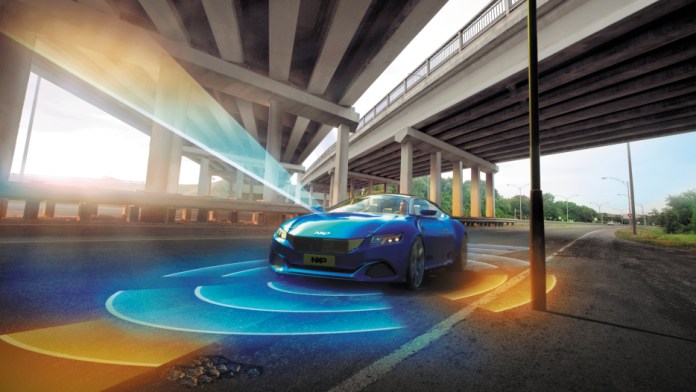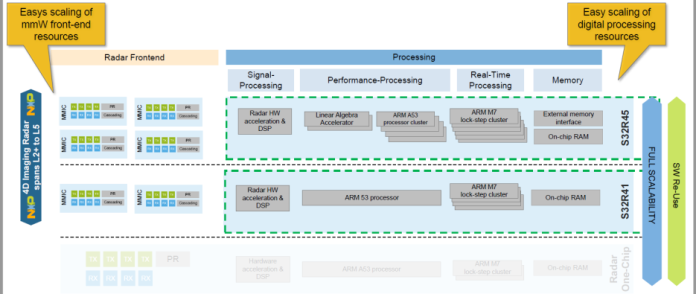NXP Semiconductors announced two updates to its automotive 4D imaging radar processor family at CES 2022. The company introduced its new S32R41 radar processor, specifically developed for the L2+ market and announced that its flagship 16-nm imaging radar processor, the S32R45, has started mass production with initial customer ramp-up starting in the first half of 2022, followed by full production by the end of the year. Together, these automotive radar chips cover the L2+ to L5 autonomy sectors, enabling 4D imaging radar for 360-degree surround sensing, said NXP.
Extending 4D imaging into a wide range of corner and front sensors, NXP claims the new S32R41 is the industry’s first 16-nm radar processor tailored for L2+ autonomous driving applications. With the new radar chip, the L2+ segment will be able to leverage 4D imaging radar sensing with up to six corner, front, and rear radar sensors in 360-degree surround sensing.

S32R41 4D imaging radar processor block diagram. Click for a larger image. (Source: NXP Semiconductors)
The S32R45 radar processor is the flagship of NXP’s 6th generation automotive radar chipset family that helps enable autonomous driving from L2+ through L5 use cases, where more than ten imaging radar sensors per vehicle may be required, said NXP. The radar processor also can be used in transportation, traffic management, and industrial applications where high-resolution sensing is required.

S32R45 4D imaging radar processor block diagram. Click for a larger image. (Source: NXP Semiconductors)
While the S32R45 has enabled for the first time a dedicated image and radar processor for autonomous driving cases, NXP felt that in order to go broader into the mid-range vehicle market a dedicated solution would be required since there isn’t a one-size-fits-all solution, said Matthias Feulner, NXP’s senior director of ADAS.
“For that reason now we are introducing the S32R41, which is specifically aimed at enabling those Level 2+ use cases which present a much larger volume market with a goal to have 360-degree surround sensing with much more capable sensors to enable better object detection, better object separation, and better object classification to see that bicycle that is driving next to a truck or see that pedestrian that is stepping out from in between two parked vehicles,” he said.
Classical radar would be able to detect that there are objects in the distance but wouldn’t be able to discriminate what the object is and wouldn’t easily be able to discriminate between two objects spaced closely together from one another, he added.
This is where 4D imaging radar makes a real difference with the imaging part enhancing the resolution of the radar substantially and enabling the imaging radar to generate a high-density point cloud, or the ability to deliver better than one-degree angular resolution, Feulner said. “This allows us now to see that bicycle next to the truck and the pedestrian stepping out in between two parked cars.”

4D imaging radar for 360-degree surround sensing. Click for a larger image. (Source: NXP Semiconductors)
Adding the fourth dimension, elevation (in addition to the three dimensions of distance, speed and angle of arrival), on top of the high-resolution angular sensing enables the imaging sensor to better see what type of object it is – a truck, car, bicycle, pedestrian, or even detect a fine feature such as a curbstone at the roadside, he said. “This is a prerequisite but I wouldn’t say it is table stakes because it is reasonably difficult to get there.”
What really differentiates NXP’s 4D imaging sensor, he said, is its 3-in-1 multi-mode radar sensing across short-, mid-, and long-range operation. NXP is reportedly the first in the market with multi-mode capability, which enables the simultaneous sensing of a very wide field of view around the car.
Feulner describes the S32R platform as a new class of imaging radar sensors with a concurrent multi-mode capability that can simultaneously observe in a medium range mode with a wider field of view, observe the vehicles in adjacent lanes for lane change capability, and at the same time accurately detect the velocity of objects in a far distance as much as 300 meters away. “The new generation of sensors does that concurrently which is different from what was possible previously,” he said.
NXP said this was achieved by using an innovative architecture to boost performance beyond raw sensor hardware capabilities with a low-complexity sensor configuration that uses 192 virtual antenna channels. This entailed a combination of proprietary radar hardware acceleration, super-resolution radar software algorithms to achieve sub-degree angular resolution, and advanced MIMO waveforms that allow for simultaneous operation of the antenna channels.
“We developed proprietary radar hardware acceleration, so it is a special IP, which we call the linear algebra accelerator, that is very efficient and does the heavy-lifting number crunching, delivering the compute performance equivalent up to 64× a standard processor core,” said Feulner.
“Second, we use super-resolution radar algorithms that we have developed in-house which allows us to enhance the sensor resolution beyond raw hardware capability. We operate with a rather modest number of virtual antennas – 192 – plus the resolution enhancement for efficient implementation,” he added.
“Third and last but not least there is the application of proprietary MIMO waveforms. MIMO is a concept that is commonly used in 5G mobile infrastructure systems. The antennas form multiple beams where part of the antenna points in one direction and the other part points to another direction to focus the energy where the user is with a cell phone to get the best possible data rate,” he said.
NXP uses the MIMO in a similar way where different parts of the antenna are dedicated to short-range, medium-range, and long-range operation. “Since we translate simultaneously from all of these antennas we need to be able to tell on the receiving side where these signals came from. That is why we put certain signatures using these MIMO waveforms onto the individual antennas,” Feulner said.
The 3-in-1 sensing enables very efficient operation without a lot of cost and overhead, he added.

NXP’s 4D imaging radar delivers simultaneous 3-in-1 sensing. Click for a larger image. (Source: NXP Semiconductors)
In addition, the S32R radar sensors are built on a common architecture for software reuse and faster development across autonomous driving levels. The scalable radar platform allows NXP to scale across use cases with common IPs for both the processor subsystem and mmWave front-end. This means NXP can tailor the products to meet specific use-case requirements.
“We see a bifurcation for imaging radar between those use cases that are aimed at full autonomy where we target the S32R45 that can connect to as many as four radar front-ends and its little brother the S32R41 aimed at a much wider range of use cases at Level 2+ autonomy that can connect to as many as two radar front-ends,” he said.

4D imaging radar bifurcation requires tailoring of solutions to the use case. Click for a larger image. (Source: NXP Semiconductors)
When the S32R radar sensors are combined with NXP’s TEF82xx RFCMOS transceivers, it becomes a complete radar sensor solution with the fine resolution, processing power, and range required for production-ready imaging radar systems.
NXP will demo its radar capabilities via an imaging radar sensor built in collaboration with radar platform and ADAS application specialist CubTEK, showcasing enhanced 4D sensing capability. Due to the strict COVID-19 rules, NXP invites visitors to book an appointment slot for the live demonstration of the S32R45 imaging radar system.
Advertisement
Learn more about NXP Semiconductors





